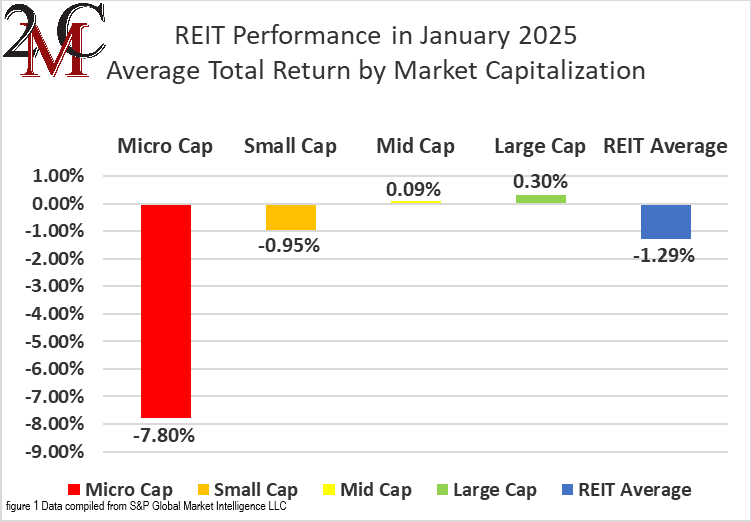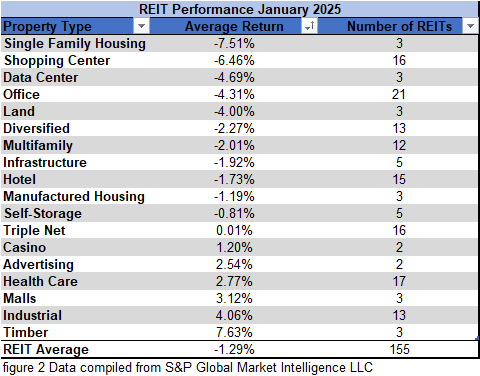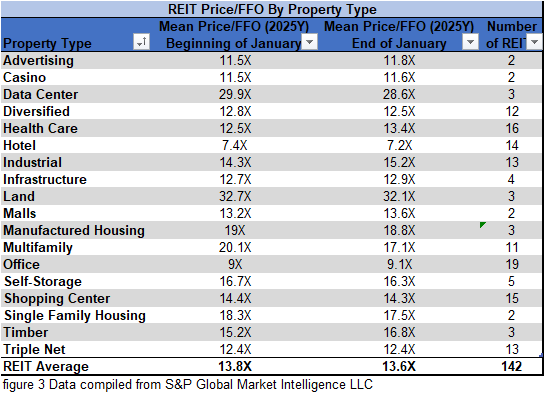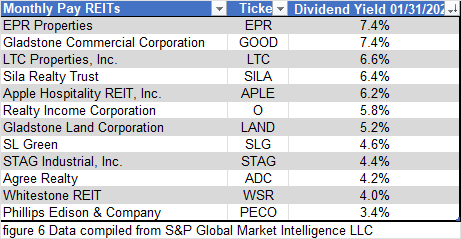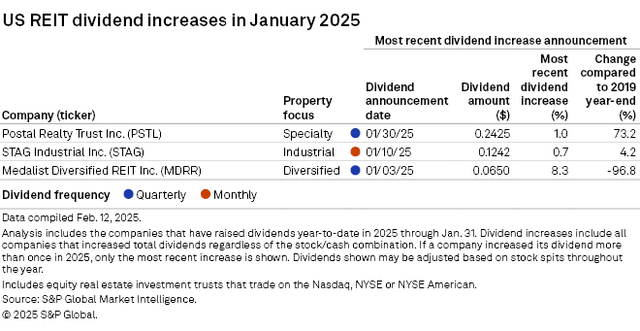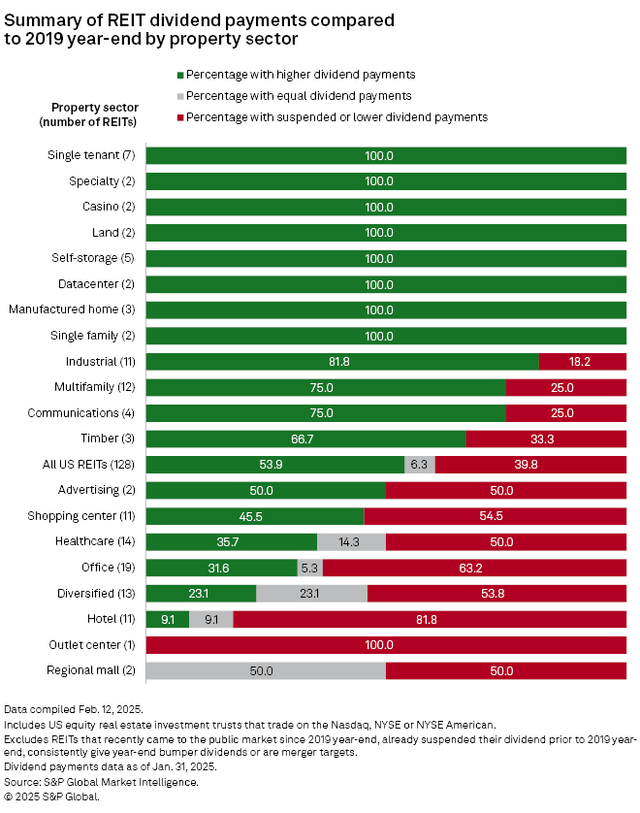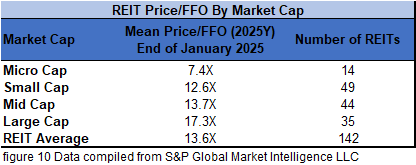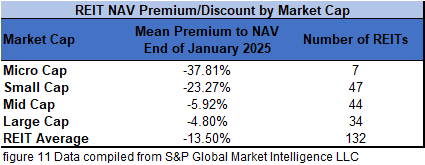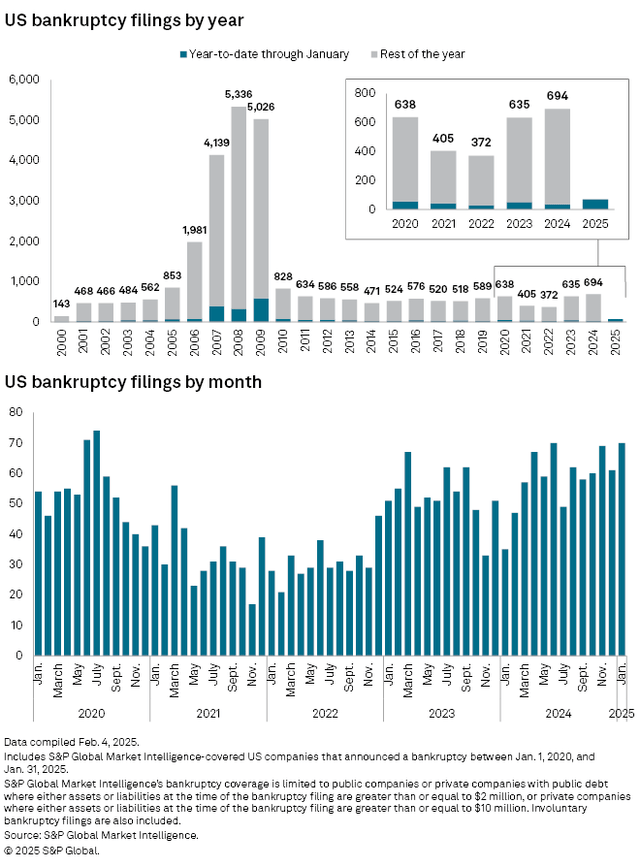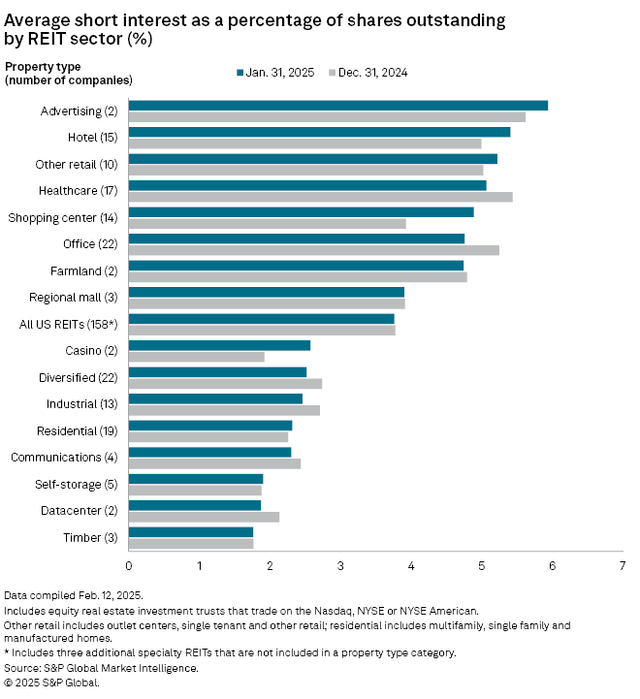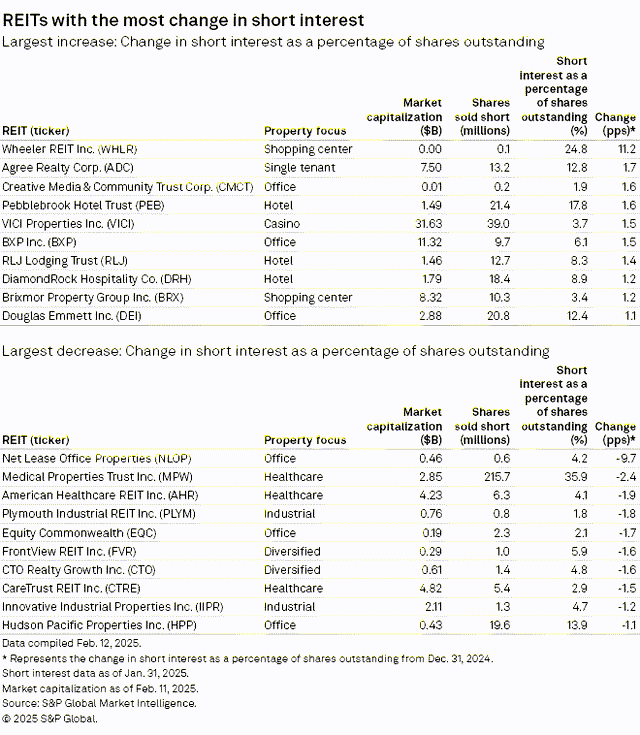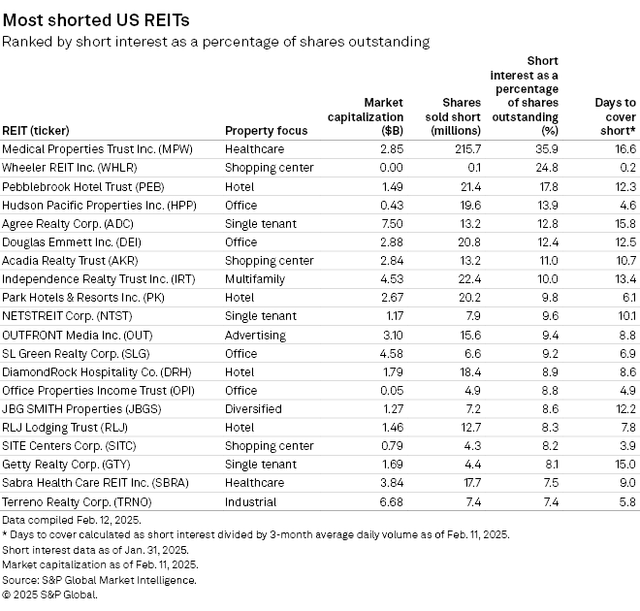The State of REITs: February 2025 Edition
- After a brutal December (-6.85%), the REIT sector averaged negative total returns again in January (-1.29%).
- Large cap (+0.30%) and mid cap REITs (+0.09%) averaged small gains in January, whereas small caps (-0.95%) and micro caps (-7.80%) started the year in the red.
- Only 42.58% of REIT securities had a positive total during the first month of 2025.
- 61% of REIT property types averaged negative total returns in January with Single Family Housing (-7.51%) and Shopping Centers (-6.46%) having a particularly rough start to the year. Timber (+7.63%) and Industrial (+4.06%) achieved the strongest gains in January.
- The average REIT NAV discount widened slightly from -13.14% to -13.29% during January. The median NAV discount also widened from -12.92% to -14.20%.
REIT Performance
REITs kicked off 2025 with a modestly negative January average total return of -1.29%. REITs fell short of the broader market as the Dow Jones Industrial Average (+4.8%), S&P 500 (+2.8%) and NASDAQ (+1.7%) all saw gains to start the year. The market cap weighted Vanguard Real Estate ETF (VNQ) outpaced the average REIT in January (+1.65% vs. -1.29%). The spread between the 2025 FFO multiples of large cap REITs (17.3x) and small cap REITs (12.6x) widened in January as multiples expanded 0.1 turns for large caps but contracted 0.9 turns for small caps. Investors currently need to pay an average of 37.3% more for each dollar of FFO from large cap REITs relative to small cap REITs. In this monthly publication, I will provide REIT data on numerous metrics to help readers identify which property types and individual securities currently offer the best opportunities to achieve their investment goals.
Micro cap REITs (-7.80%), which severely underperformed their larger peers in 2024, continued their losing streak in January. Large caps (+0.30%) and mid caps (+0.09%) eked out narrow gains, but small caps (-0.95%) averaged a modest negative return. After the first month of 2025, large cap REITs have outperformed small caps by 126 basis points.
7 out of 18 Property Types Yielded Positive Total Returns in January
38.9% of REIT property types averaged a positive total return in January. There was a 15.14% total return spread between the best and worst performing property types. Timber (+7.63%) and Industrial (+4.06%) had the strongest start to 2025. Single Family Housing (-7.51%) and Shopping Center REITs (-6.46%) started the year deep in the red.
The REIT sector as a whole saw the average P/FFO (2025Y) decrease 0.2 turns in January from 13.8x down to 13.6x. 50% of property types averaged multiple contraction, 44.4% averaged multiple expansion and 5.6% saw multiples hold steady in January. Land (32.1x), Data Centers (28.6x), Manufactured Housing (18.8x), Single Family Housing (18.3x) and Multifamily (17.1x) currently trade at the highest average multiples among REIT property types. Hotels (7.2x) and Office (9.1x) are the only property types that average single digit FFO multiples.
Performance of Individual Securities
Medical Properties Trust (MPW) (+18.73%) outperformed all other equity REITs in a very event-filled month for the health care REIT. MPW’s long struggling tenant Prospect Medical Holdings finally filed for bankruptcy on January 11th and on January 31st MPW refinanced large loans that would have matured in 2025 and 2026 with new notes maturing in 2032.
Creative Media & Community Trust (CMCT) (-66.22%) plummeted in January. CMCT announced a 1-for-10 reverse stock split on the first trading day of the year, but the share price continued to rapidly collapse down toward the pre-split price.
42.58% of REITs had a positive total return in January. REITs averaged a -1.29% total return in January 2025, which was actually a less painful start to the year than REITs had the prior January (-5.72%).
For the convenience of reading this table in a larger font, the table below is available as a PDF as well.
Although only 9.68% of REITs had a positive total return in December, 55.63% managed to achieve a positive return for the full year. REITs averaged a +3.70% total return in 2024, which fell short of the +8.66% average return for the REIT sector in 2023.
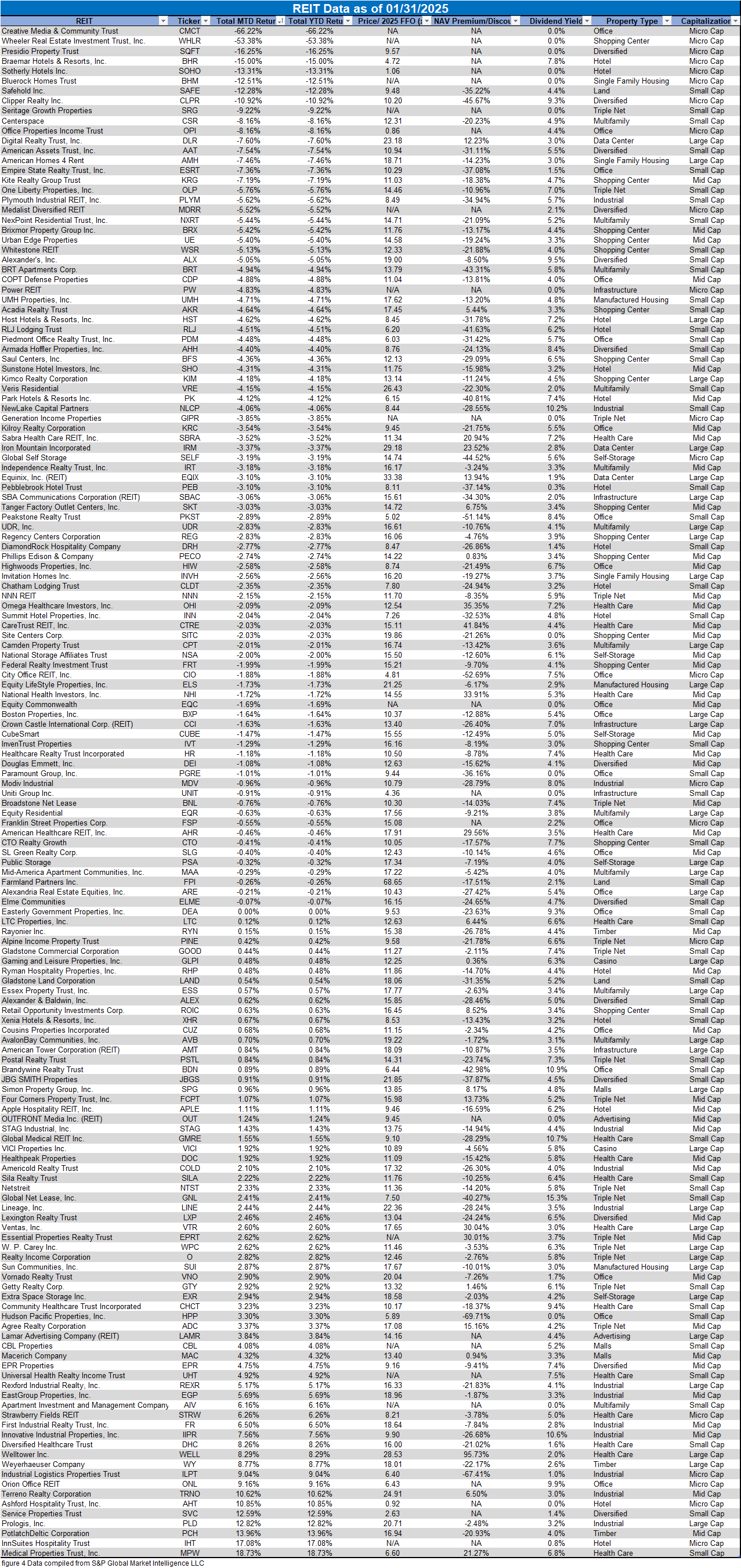
Dividend Yield
Dividend yield is an important component of a REIT’s total return. The particularly high dividend yields of the REIT sector are, for many investors, the primary reason for investment in this sector. As many REITs are currently trading at share prices well below their NAV, yields are currently quite high for many REITs within the sector. Although a particularly high yield for a REIT may sometimes reflect a disproportionately high risk, there exist opportunities in some cases to capitalize on dividend yields that are sufficiently attractive to justify the underlying risks of the investment. I have included below a table ranking equity REITs from highest dividend yield (as of 1/31/2025) to lowest dividend yield.

Although a REIT’s decision regarding whether to pay a quarterly dividend or a monthly dividend does not reflect on the quality of the company’s fundamentals or operations, a monthly dividend allows for a smoother cash flow to the investor. Below is a list of equity REITs that pay monthly dividends ranked from highest yield to lowest yield.
A majority (53.9%) of REITs currently pay a higher dividend than they did pre-covid (the end of 2019). 6.3% have the same dividend they did pre-covid and 39.8% have a reduced or suspended dividend.
A number of REIT property types saw across the board dividend increases since the end of 2019. 100% of REITs have increased their dividend within the Single-tenant Triple Net, Casino, Land, Self-storage, Data Center, Manufactured Housing and Single Family Housing property types. However, none of the Mall or Outlet Center REITs have a higher dividend today than they did at the end of 2019.
Valuation
REIT Premium/Discount to NAV by Property Type
Below is a downloadable data table, which ranks REITs within each property type from the largest discount to the largest premium to NAV. The consensus NAV used for this table is the average of analyst NAV estimates for each REIT. Both the NAV and the share price will change over time, so I will continue to include this table in upcoming issues of The State of REITs with updated consensus NAV estimates for each REIT for which such an estimate is available.
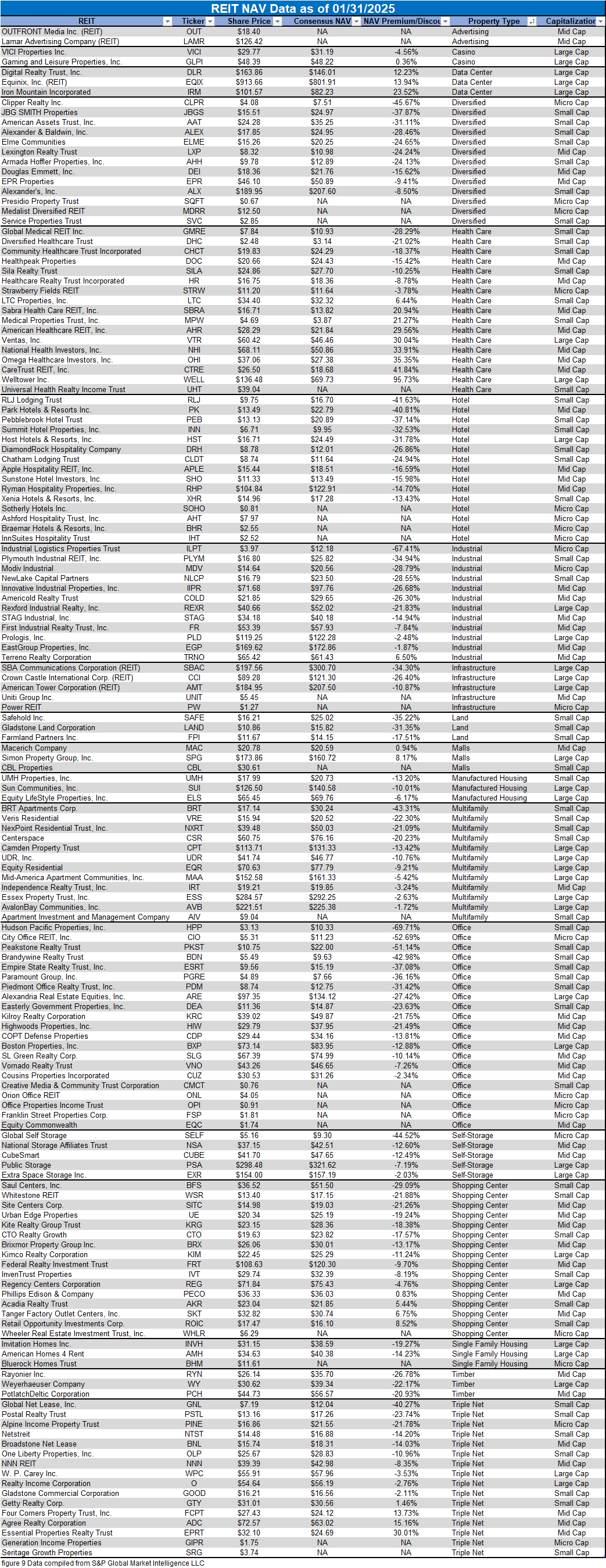
Takeaway
The large cap REIT premium (relative to small cap REITs) widened in January and investors are now paying on average about 37% more for each dollar of 2025 FFO/share to buy large cap REITs than small cap REITs (17.3x/12.6x – 1 = 37.3%). As can be seen in the table below, there is presently a strong positive correlation between market cap and FFO multiple.
The table below shows the average NAV premium/discount of REITs of each market cap bucket. This data, much like the data for price/FFO, shows a strong, positive correlation between market cap and Price/NAV. The average large cap REIT (-4.80%) and mid cap REIT (-5.92%) trade at mid single-digit discounts to NAV. Small cap REITs (-23.27%) trade at a little over 3/4 of NAV and micro caps (-37.81%) trade at less than 2/3 of their respective NAVs.
REITs Overall Saw a Slight Decrease in Short Interest in January, But Short Interest Remains Very High for Some REITs
Average REIT short interest remained largely flat in January as it declined by just 1 basis point to 3.8% of shares outstanding. Advertising REITs continue to average the highest short interest (5.9%) followed by Hotels (5.4%). Timber (1.8%) and Data Centers (1.9%) had the lowest average short interest at the end of January. Shopping Center REITs saw the highest increase in average short interest (+96 bps) in January, whereas Office REITs averaged the largest decrease (-65 bps).
Wheeler REIT (WHLR) saw the biggest increase (+11.2%) in short interest in January as the share price continues a multi-year freefall. Agree Realty (ADC) (+1.7%) and Creative Media & Community Trust (CMCT) (+1.6%) rounded out the top 3 short interest increases. The 10 REITs that saw the biggest declines in short interest were concentrated in 4 property types: Office, Healthcare, Industrial and Diversified. Net Lease Office Properties (NLOP) saw the biggest decline in short interest (-9.7%) followed by Medical Properties Trust (MPW) (-2.4%) and American Healthcare REIT (AHR) (-1.9%).
Closing a short position requires buying back shares in the position that was shorted. This means that companies with very high short interest can potentially experience strong upward pressure on share price when the short thesis materially weakens. A 2.4% reduction in the short interest of MPW helped propel the healthcare REIT to the highest total return in the REIT sector in January. With 35.9% of shares of MPW still held short and a whopping 16.6 days to cover, this heavy short interest could prove to be a strong tailwind if the short thesis fails to play out. Other REITs with high days to cover are Agree Realty Trust (ADC) (15.8 days), Getty Realty (GTY) (15.0 days) and Independence Realty Trust (IRT) (13.4 days). Heavy short interest can often be warranted by material risks and/or declining fundamentals, so it is important to fully understand these issues prior to initiating either a long or short position in any REIT. However, there is a potential for outsized gains when an investor correctly identifies which highly shorted REITs will not see the short thesis come to fruition.
Important Notes and Disclosure
All articles are published and provided as an information source for investors capable of making their own investment decisions. None of the information offered should be construed to be advice or a recommendation that any particular security, portfolio of securities, transaction, or investment strategy is suitable for any specific person. The information offered is impersonal and not tailored to the investment needs of any specific person.
We cannot determine whether the content of any article or recommendation is appropriate for any specific person. Readers should contact their financial professional to discuss the suitability of any of the strategies or holdings before implementation in their portfolio. Research and information are provided for informational purposes only and are not intended for trading purposes. NEVER make an investment decision based solely on the information provided in our articles.
We may hold, purchase, or sell positions in securities mentioned in our articles and will not disclose this information to subscribers, nor the time the positions in the securities were acquired. We may liquidate shares in profiled companies at any time without notice. We may also take positions inconsistent with the information and views expressed on our website.
We routinely own and trade the same securities purchased or sold for advisory clients of 2MCAC. This circumstance is communicated to our clients on an ongoing basis. As fiduciaries, we prioritize our clients’ interests above those of our corporate and personal accounts to avoid conflict and adverse selection in trading these commonly held interests.
Past performance does not guarantee future results. Investing in publicly held securities is speculative and involves risk, including the possible loss of principal. Historical returns should not be used as the primary basis for investment decisions. Although the statements of fact and data in this report have been obtained from sources believed to be reliable, 2MCAC does not guarantee their accuracy and assumes no liability or responsibility for any omissions/errors
Commentary may contain forward-looking statements that are by definition uncertain. Actual results may differ materially from our forecasts or estimations, and 2MCAC and its affiliates cannot be held liable for the use of and reliance upon the opinions, estimates, forecasts, and findings in this article.
Through October 2021, The State of REITs was published exclusively on Seeking Alpha by Simon Bowler, Sector Analyst at 2nd Market Capital Services Corporation (2MCSC). Editions subsequent to October 2021 will be published on this website in addition to other platforms that may include Seeking Alpha. 2MCSC was formed in 1989 and provides investment research and consulting services to the financial services industry and the financial media. 2MCSC does not provide investment advice. 2MCSC is a separate entity but related under common ownership to 2nd Market Capital Advisory (2MCAC), a Wisconsin registered investment advisor. Simon Bowler is an investment advisor representative of 2MCAC. Any positive comments made by others should not be construed as an endorsement of the author's abilities to act as an investment advisor.
S&P disclosure: S&P Global Market Intelligence LLC. Contains copyrighted material distributed under license from S&P.
Discover more from 2nd Market Capital Advisory Corp
Subscribe to get the latest posts sent to your email.
